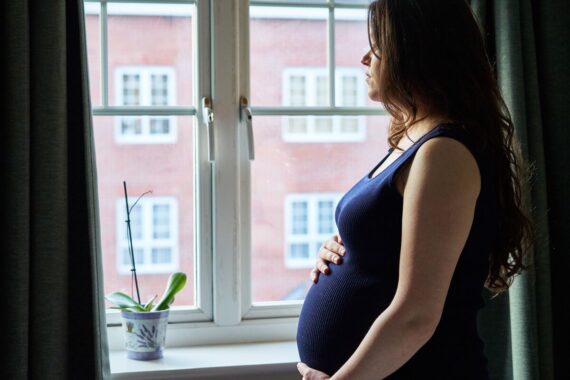Consultant perinatal psychiatrist Dr Emma Fisher discusses the options for a woman with a history of treatment for depression who presents during pregnancy asking to start antidepressant treatment again
You see a 28-year-old woman who is in the early stages of pregnancy. She has a past history of depression which has required antidepressant treatment on many occasions. She is positive about her pregnancy and has good support from home from her partner, but she feels her depression is recurring and requests that she restarts antidepressant treatment.
What are the risks of starting antidepressants in pregnancy – compared to the risks of untreated depression?
Pregnancy is not protective for mental illness, and many people experience not only a relapse of a previous mental illness postnatally, but also antenatally. First episodes of depression also occur in pregnancy. The prevalence of antenatal depression is around 12% so it is a common condition among pregnant women.
As this patient is likely in the first trimester the risk of teratogenicity should be considered, as with any medication given during this time. Both first-line antidepressants (SSRIs such as sertraline, fluoxetine and citalopram) and second-line antidepressants (including mirtazapine, venlafaxine and imipramine) are commonly used in pregnancy and any risk of teratogenicity with their use in the first trimester is low.
However, some women may choose to wait until the second trimester to start treatment, in which case it is important to discuss the risks posed towards the end of pregnancy, as it would be for a woman who has started treatment prior to pregnancy or in the first trimester. Antidepressants, due to their effects on platelets, can increase the risk of postpartum haemorrhage. There is also thought to be a small increased risk of the rare condition of persistent pulmonary hypertension of the newborn from around 1/1000 births to 2-3/1000. As the foetus is exposed to a small amount of the medication via the placenta, at birth, infants can experience mild withdrawal symptoms such as irritability and being slow to feed. These symptoms are usually self-limiting and require no additional monitoring or treatment; breastfeeding may decrease the risk of withdrawal symptoms as the infant continues to receive a small amount via the breastmilk. Some studies suggest that using antidepressants in pregnancy can increase the risk of preterm labour, with the greatest risk associated with use in the third trimester.
It also important to counsel the woman regarding the risk of untreated depression in pregnancy, so that the risks and benefits of both options are considered and weighed. This is so often missed despite research showing that there are clear risks to both the foetus and the mother from untreated depression in pregnancy. These include premature birth, low birth weight and increased risk of longer term behavioural and emotional difficulties in the offspring. Antenatal depression is also a predictor of postnatal depression, which increases the risk of bonding difficulties with potential detrimental effects on both mother and baby.
Also consider how severe the patient’s past depressive episodes were, and any risks associated with that. For example, if the patient’s previous depressive episodes were so severe she could not function, had attempted suicide or had needed hospital admissions, but she had responded well to medication, it’s likely that the benefits of starting medication would outweigh the risks at this stage. By contrast if the patient tells you that when previously prescribed antidepressants, she did not actually take them on a number of occasions, or that she had mild depressive symptoms that were usually triggered by a stressful event at work and which resolved by themselves after a few weeks, a decision to ‘watch and wait’ and hold off medication may be a valid plan.
We should empower women to make the best decisions for themselves and their families by giving them information on the risks and benefits of all available treatment options, and also of no treatment. However, just as we would advise patients on physical health treatment and recommend certain interventions, we should not shy away from doing the same for mental health conditions. Leaving it up to the woman herself and shying away from recommending a treatment, might be denying that woman the ‘permission’ she is seeking to accept the treatment she needs, especially when maternal guilt is at play.
If treatment is required, do we know which medication options are ‘safest’?
When considering safety, we need to consider not only safety to the foetus, but also to the mother in terms of risk that her depression and suboptimal treatment may pose. A ‘safe’ antidepressant is not safe if it is ineffective in treating the depression.
In terms of the SSRI antidepressants, sertraline crosses the placenta in slightly smaller amounts, and is found in the breast milk in smaller amounts, than the other SSRIs. It is a first-line antidepressant for the general population and therefore pregnant women who are antidepressant naïve are usually recommended this first. However, in this case the patient has previously been on antidepressants, so the right choice will usually be the medication that has previously worked best for her.
Antidepressants are generally considered safe in pregnancy so any difference in safety between them, especially between the SSRIs, is likely extremely small. Hence there is no basis for choosing sertraline over a different antidepressant that was previously effective – it could mean the patient doesn’t respond to treatment, leading to her depression worsening and exposing the foetus to higher levels of cortisol, and necessitating a switch to a different medication, thereby exposing the foetus to two antidepressants unnecessarily. The same principle holds for women who have previously responded best to second-line antidepressants such as mirtazapine, duloxetine or venlafaxine. Assuming any previous trials of SSRIs were adequate and at therapeutic doses, trying an SSRI again just because the patient is pregnant is unlikely to give different results.
It is also worth mentioning that the full dose range of antidepressants can be used. There is no benefit to using a low dose that treats the depression suboptimally – the foetus is then exposed to both the medication and the effects of inadequately treated depression.
What are the alternatives in this situation?
Talking therapy could be offered as an alternative to medication and cognitive behavioural therapy (CBT) is an effective treatment for depression. Many local NHS talk therapy services offer fast tracking or a priority service for women in the perinatal period. Exercise can be an effective treatment for depression and appropriate exercise should still be recommended in pregnancy, but many women stop exercising when pregnant for fear of harm to themselves or baby. Stopping regular exercise in itself can be a risk factor for developing low mood. It is also worth remembering that low mood in pregnancy may be caused by a number of social factors and that signposting to relevant agencies such as domestic abuse charities may be appropriate. Early studies indicate home transcranial direct current stimulation (tDCS) devices are a promising non-pharmacological option for use in pregnancy.
Dr Emma Fisher is a consultant perinatal psychiatrist at Northamptonshire Healthcare NHS Foundation Trust














